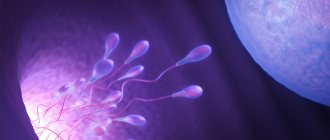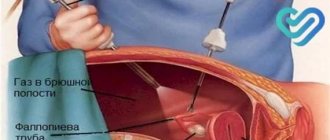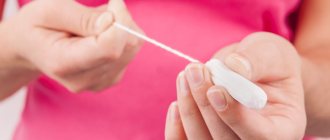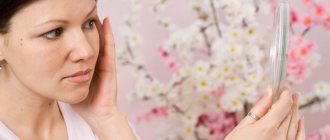The beginning of menstruation for every girl is an important event for which she mentally prepares in advance. Modern teenagers are well acquainted with this physiological process. Some people's mothers tell about it, some read about it on the Internet, some hear about it from their friends. Usually girls under the age of ten themselves begin to ask their mothers about this, and rightly so. After all, a loved one will try to “clearly” explain to their child how this process occurs and how to prepare for it. There is only one question that torments all girls: how to find out when their first period begins.
Before the start of menstruation, the mother should talk about this with her daughter
What is menstruation
Menstruation is a normal process that occurs in the female body. Menstruation indicates the body’s preparation for possible fertilization and full bearing of a child. Critical days are characterized by monthly withdrawal of blood from the genitals.
What women see on the pad is the top layer of the endometrium. It comes out along with the unfertilized egg.
With successful conception, a long delay occurs, which is also commonly called artificial menopause. The menstrual cycle will be restored only after delivery and cessation of breastfeeding, less often before breastfeeding.
Girls' cycles should be regular and last about a month.
Throughout the menstrual cycle, natural hormonal changes occur in a woman’s body. In the middle of the cycle, ovulation occurs - the most favorable day for fertilization, when the egg leaves the ovaries. Before her period, a girl will have to deal with premenstrual syndrome.
The menstrual cycle lasts 28-34 days. The indicator may be less or more depending on individual characteristics. Menstruation itself lasts up to 7 days. At this moment, the body's protective function decreases. Various pathological processes that have been asymptomatic for a long time may appear. It is advisable to rest more during menstruation and slightly reduce your usual level of physical activity.
Common causes of missed periods
In the absence of menstruation in adolescents aged 13-16 years, gynecologists suspect a delay that does not correspond to normal indicators of physiological development during puberty. The most common reasons for the absence of menstruation in adolescents include the following:
- Inflammatory diseases of the genitourinary area (endometriosis, polycystic ovary syndrome, cystitis and other diseases). This fact should be excluded first of all in the absence of signs of an inflammatory process. It is impossible to ignore any reproductive function disorders during adolescence. An infection that is not destroyed in a timely manner becomes a trigger for the appearance of chronic gynecological diseases. Female infertility is often caused by the lack of proper treatment.
- Pregnancy is a fact that cannot be ignored, despite such an early age of 11-13 years. The beginning of puberty requires a special approach to personality development. Building trusting relationships at this time is the task of every parent. A girl should be confident in the support of her parents in any situation. Sex education plays a big role. Conversations on the topic of gender should be held from preschool age. Lack of knowledge about contraceptive methods leads to irreparable consequences.
- Traumatic brain injuries often disrupt the natural menstrual cycle. Trauma experienced in childhood can cause reproductive dysfunction in the future. This fact should be reported to the gynecologist without fail. You may need to consult a neurosurgeon.
- Endocrine diseases (diabetes mellitus, thyroid disease) often provoke menstrual irregularities in girls 12 years of age and older. Treatment of systemic diseases should precede examination of reproductive function.
- Hormonal imbalance is observed during the period of physiological maturity. Lack of mammary gland growth, a rough voice, and male-pattern hair growth indicate a lack of estrogen and a predominance of male sex hormones in the body. In this case, hormonal therapy is indicated to correct the imbalance.
- Anomalies in the development of the reproductive organs and injuries resulting from mechanical damage or surgery can cause the absence of menstruation. A doctor can diagnose the anomaly during a gynecological examination. This pathology is most often diagnosed in the absence of menstruation in a teenager 15 years of age or older.
- Increasing physical activity is a common reason why your period may be delayed. For teenagers who lead an active lifestyle (going to the gym, dancing, extreme sports), a delay in menstruation of 1 year or more is not uncommon. When performing strenuous physical exercise, fat is burned, as a result of which the brain blocks ovulatory function. You need to understand that the puberty period requires compliance with a gentle regime in order to avoid unpleasant consequences.
- Increased mental stress is an equally common fact. A difficult school curriculum, additional classes with a tutor, and lack of free time provoke delays due to mental overstrain.
- The emotional instability that characterizes this period explains why periods may be late. The first love, difficult relationships with peers or parents leave a deep mark on the vulnerable child’s soul. When this factor is eliminated, the menstrual cycle is restored.
- A sharp change in body weight, observed when using strict diets, determines why menstruation does not come on time. Limiting the consumption of high-calorie foods at the age of 12-17 years is a widespread phenomenon among adolescents. Anorexia nervosa is a trigger not only for dysfunction of the reproductive system, but also for the entire body as a whole. Obesity also disrupts the natural menstrual cycle.
- Bad habits such as drinking alcohol, drugs and smoking can be the reason why there is no menstruation at 12-17 years of age.
- Changes in the climatic zone of residence provoke menstrual irregularities (premature onset or delay). If menstruation is absent for this reason, then there is no reason to worry. The acclimatization period is a temporary phenomenon. After some time, the natural cycle will be restored.
- The use of certain medications affects the reproductive function of a young body. For example, synthetic analogues of hormones. When diagnosing the pathology, it is necessary to exclude the girl’s use of hormonal contraceptives. They directly affect the absence of menstrual flow.
At what age do menstruation appear?
The age at which menstrual days appear and the factors influencing their onset are presented in the table.
| In what age group do they appear? | Surprisingly, just a few decades ago, menstruation occurred at the age of 16-19 years, and this was considered the norm. However, every year the threshold of puberty decreases, and the age over 15 for the first menstruation is already considered late and is considered as a probable deviation. Today, the optimal time to start menstruation is considered to be 11-15 years. Depending on certain individual characteristics, critical days may occur at 8-9 years of age. This condition definitely requires contacting a pediatric gynecologist. Typically, such early maturation is the result of hormonal imbalances or excessive physical exertion. Gymnasts and other young athletes usually experience early menstruation. |
| What affects the onset of menstruation | The following can speed up or, on the contrary, slow down the onset of menstruation: • various diseases; • rapid weight or height gain; • diet and place of residence; • race; • general psycho-emotional background; • specific lifestyle. |
Having your period come sooner or later is not always a deviation. Body weight plays an important role. If you are overweight, your critical days will most likely come later than required. Hereditary predisposition also influences.
Excess weight can cause your first period to be late
Early and late periods
Most often, the onset of menstruation at the age of 9-10 years and after 16 is still considered normal, if this is not related to climate conditions. In case of early or late menstruation, you should consult an endocrinologist and gynecologist.
The reasons for untimely menstruation may be a malfunction of the endocrine system, which disrupts the hormonal balance of the body.
Excessive physical activity and frequent stress can cause a delay in the first menstruation.
What are the features of the first menstruation?
The first menstrual flow is usually dark, red-brown. Often your periods are scanty, but there are also cases of heavy menstruation. In adolescents, heavier discharge is usually observed on the second day of menstruation. During the first menstruation, about 150 ml of blood comes out. The condition is generally satisfactory, although there are a small number of unpleasant signs.
Menstrual flow is accompanied by a pungent odor. This is due to the increased work of the vulva. Parents before the age of 12 should talk to their daughter and explain what menstruation is so that the girl is not afraid when it appears.
At first, the cycle will only be installed. Don't worry if there are delays.
Warning signs of the first menstruation
Menstruation for the first time can occur in completely different variations: heavy or scanty, accompanied by strong or mild pain, long (7 days) or shorter (3-5 days), with brown or bloody discharge.
However, there are warning signs that should be a reason to contact a gynecologist. These include:
- The girl suddenly loses or gains weight.
- Menstruation is accompanied by very severe abdominal pain, dizziness, vomiting, and headaches.
- There is itching or burning in the perineum.
- Long delay (more than 1.5 months). It is worth paying attention to the fact that the first year of the menstrual cycle is unstable. It ranges from 21 to 40 days.
- The duration of menstruation is more than 7 days.
Information from the Internet, magazines and stories from friends is available to every girl. However, you should not avoid an important conversation with your child. A timely conversation will help avoid unwanted stress and serious consequences.
How long does your period last?
Critical days at 12 years old last from 3 to 10 days. The indicator directly depends on individual characteristics. It happens that menstruation is present in the form of a short, scanty smear.
The duration is completely normalized usually within the next month. However, this may also take 60-90 days.
The cycle may be irregular at first, don’t worry
The approach of the first menstruation, signs and preparation
Based on some signs, you can understand that the girl will soon begin her first menstruation. Mild soreness appears in the mammary glands, their volume begins to increase, hair appears on the pubis, under the arms, on the legs and arms. About 1-1.5 years before the start of menstruation, white, odorless discharge appears. If their volume increases, they become more liquid, then the first menstruation may occur within 1 month.
An attentive mother notices that the girl’s mood often changes for no reason; she has an increased interest in intimate hygiene products and changes in her own figure. Before the first menstruation appears, some people gain weight.
To ensure that a girl’s first period does not come as a surprise or cause panic, she must be prepared for its onset. A girl should know what menstruation is, what it should be like normally, why deviations are possible, and whether they are always a pathology. She should have an idea of what age her first period comes, how many days it lasts, and what the menstrual cycle should be like.
The girl needs to be told about what sensations she may have and in which case she needs advice and help from a doctor. After signs of the imminent arrival of the first period appear, the girl should always have pads with her.
Warning: Mom should explain to her daughter how to use pads and talk about the need for enhanced care of the genitals during menstruation. Otherwise, due to inexperience, an infection may be introduced into the genitals. Incorrectly chosen gaskets often leak. This causes not only discomfort, but also emotional stress.
After the appearance of menstruation, you need to start a calendar, marking the date of its beginning and end. This will allow you to monitor the regularity of your cycle and notice deviations in the nature of menstruation. The first cycles are unstable in duration and time of onset.
Video: Causes of instability of the first menstruation
What hygiene products to use
Today there is a large selection of personal care products. It is important to choose them responsibly so as not to provoke an allergy or cause an infection. Gynecologists recommend that teenage girls give preference to pads.
Pads are safer than tampons. They should be changed regularly so as not to provoke the creation of favorable conditions for the proliferation of pathogenic microorganisms.
Age should be taken into account when choosing pads. There is no need to take personal hygiene products designed for heavy discharge. The girl will be uncomfortable in them.
It is better to take two-drop pads. At the same time, the girl should be comfortable. It is better if the product is ultra-thin.
It is important to choose the right gaskets
Who should get tested when they get their first period?
The changes in body and mind that occur during hormonal changes are often frightening, and menstruation, if its onset comes as a surprise, can be very frightening.
To prevent this from happening, answer a few simple questions to find out the approximate time of its onset right now. A quick test when you get your first period is also worth taking if:
- there are suspicions that this will happen very soon;
- I want to know in advance so as not to end up in an awkward situation;
- I wonder how long to wait for the transition to the next stage of growing up;
- you think that they should have already begun, but this does not happen.
What symptoms accompany critical days?
A couple of days before the onset of menstruation, a girl will encounter the following signs:
- frequent mood changes;
- aggressive behavior;
- causeless headaches;
- discomfort in the lower abdomen.
The onset of discharge is accompanied by intense pain in the lower abdominal cavity. The girl gets tired quickly, regardless of the amount of work done. There is a high risk of intestinal upset. In addition, nausea may occur.
It is better if the girl rests during her first period and avoids any physical activity.
Conclusion
The onset of the first period is always an exciting moment in the life of every girl, which can come unexpectedly.
You should pay attention to changes in the child’s appearance and behavior in order to anticipate the approach of menarche in time. If a girl is informed about such a phenomenon as menstruation, it will be psychologically easier for her to cope with their onset.
Knowing what discharge is and what menstruation is for, it will be easier for a young girl to understand herself and her nature, and fewer embarrassing surprises await her in the future.
For what reason may menstruations be absent at 12 years old?
The complete absence of menstruation upon reaching 12 years of age is not a deviation. You should worry if they have not arrived by the age of 15. In this case, you will need to suspect the presence of a pathological process.
If you want to learn about the features of the first menstruation, watch this video:
Regular delays of 12 years are also not abnormal. You should consult a doctor if there is no discharge for more than 3 months. Critical days are influenced by the following factors:
- hormonal background;
- injuries;
- previous surgical interventions;
- bad habits;
- various medications.
A girl should be taken to a doctor if by the age of 12 she does not show signs of puberty and her figure does not become feminine.
What determines the timing of the appearance of the first menstruation?
Puberty in girls begins at about 10 years of age and ends by 17-18 years. They begin to grow mammary glands and develop genital organs. 1-1.5 years after the start of maturation, the first menstruation (menarche) appears. The ovaries begin to function and female sex hormones are produced. At this time, ovulation occurs, and pregnancy may occur.
The timing of this period depends on the following factors:
If a girl was often sick since childhood, had congenital pathologies, or had to take a lot of medications, then menstruation may appear later. The norm is the appearance of the first menstruation at the age of 12-15 years. If it occurs at the age of 8-10, it is considered that menstruation is early, and if after 15 years, then it is considered late. In both cases, the causes of deviations are most often hormonal disorders or improper development of the genital organs.










